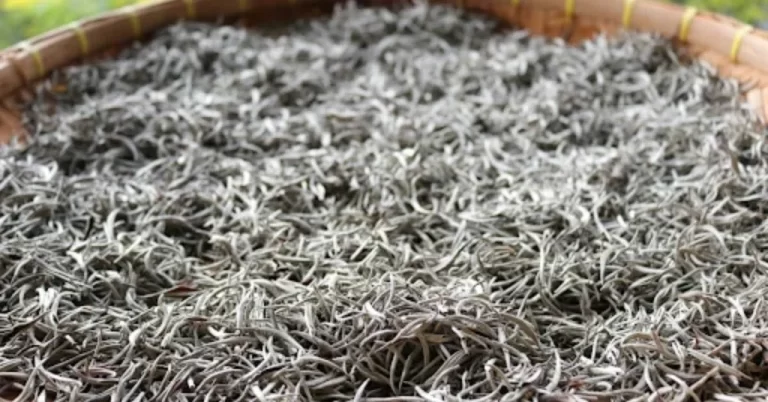Ok, for today I was thinking of something a little different. We’ll look into each type of tea and we are starting with the White Tea.
Although white tea was popularized and widely revered in the Song Dynasty (960-1269), it was relatively unknown to the rest of the world until very recently. Fortunately, due to studies on it’s marvelous benefits, it is beginning to be seen more often in European countries.
“Why is it called White?” you might ask.
No, the tea is not white when brewed, in fact it is a pale yellow.
The name comes from the fine silvery-white hairs on the unopened buds of the tea plant, which give the plant a whitish appearance. Yes, the same plant we refer to when we speak of tea: The one and only Camellia Sinensis.
Now here comes the tricky part: if you do some research you will see that internationally there’s not much agreement in the definition of the white tea.
There is the “only dried with no additional processing” description, the affirmation that the tea is made from the buds and immature tea leaves picked shortly before the buds have fully opened and allowed to wither and dry in natural sun and some other experts say that the tea includes the buds and very young leaves which have been steamed or fired before drying.
One thing is for sure: the process of making the loose leaf white tea does not involve the leaves being rolled nor oxidized.
That is why the white tea is more delicate in flavor than most green teas and definitely lighter than black teas.
White tea was traditionally harvested in China, Fujian region but due to demand recently started beying harvested as well in Taiwan, Nepal, Thailand, Sri Lanka and India.

Let’s talk Caffeine (you can look into a more detail breakdown on this subject here)
Green tea is associated usually with teas for weight loss. However, both green and white teas have same levels of caffeine and catechins (like epigallocatechin gallate – EGCG), compound linked to burning fat. Together this compounds have a symbiotic effect.
Recent studies on white tea extract showed that this not so known tea has the ability to stimulate fat breakdown and prevent new fat cells from being formed, and this was largely due to ECGC. They also show that white tea may help boost your metabolism by an extra 4-5%, that would be equal to burning an extra 70-100 calories per day, not bad I would say.
Protecting the teeth from Bacteria
A great source of tannins, catechins and flouride, a combination that it is believed to strengthen the teeth by fighting bacteria and sugar.
Catechins (antioxidants) are abundant in white tea and are known to inhibit the growth of plaque bacteria. In fact the combination of the flouride, catechins and tannins are known to inhibit the growth of plaque-causing bacteria
The big word: Cancer
As I said, the studies just began so there is still much to be made in research involving white tea but the test tube studies show great results. It appears that white tea extract triggered cell death in several types of lung cancers and suppressed the growth of colon cancer cells and stopped them from spreading.
Also the studies showed that white tea extract also protected normal cells from damage by harmful molecules.
I guess we have to wait for the results of further studies but white tea does look very promising in suppressing cancer cells and stop them from spreading.
What about the Insulin Resistance?
Unfortunately Insulin Resistance is common this days and is linked to a number of chronic health conditions like type 2 diabetes, heart disease and metabolic syndrome.
The polyphenols in white tea can lower your risk of insulin resistance according to studies.
In a study involving over 1100 people scientist found that molecules inside white tea like the polyphenols reduce blood sugar and insulin levels significantly.
Of course, again, more needs to be done but human test are very promising.
Same for the catechins in white tea that seems can lower the risk of osteoporosis as they promote bone growth and suppress bone breakdown.
Due to the EGCG (found in white tea) that I was talking earlier has been linked to lower risk of Alzheimer’s and Parkinson’s.
This statement is supported by 8 studies involving 5,600 people that showed that people who drank tea had 15% lower risk of Parkinson’s disease than people who did not drink tea. Another analysis of 26 studies on almost 53,000 people found that drinking tea daily was linked to 35% lower risk of brain disorders like Alzheimer’s disease
OK. OK, enough with the science
Another plus…Easy to make
Just pay attention to the temperature of the water, never use boiling water as the tea is very delicate and you will ruin the taste!
You don’t need fancy tea makers or thermometers. Just put a pot with filtered water on the stove with medium heat. When you see bubbles forming on the bottom of the pan but before the vapors start to form or the water begins to actually boil turn off the heat. If you already went to far, no problem, just let the water cool down for a couple of minutes.
When water is done put the leaves in your teapot (I prefer the ones with strainer for easy cleaning like this one) or a strainer that goes directly in the cup (Llike this one) or teapot (like this)
After the brewing time (Usually 2 minutes but every loose leaf tea usually comes to the information for brewing) you just pop the strainer out and there it is, your perfect cup of white tea.
Enjoy!